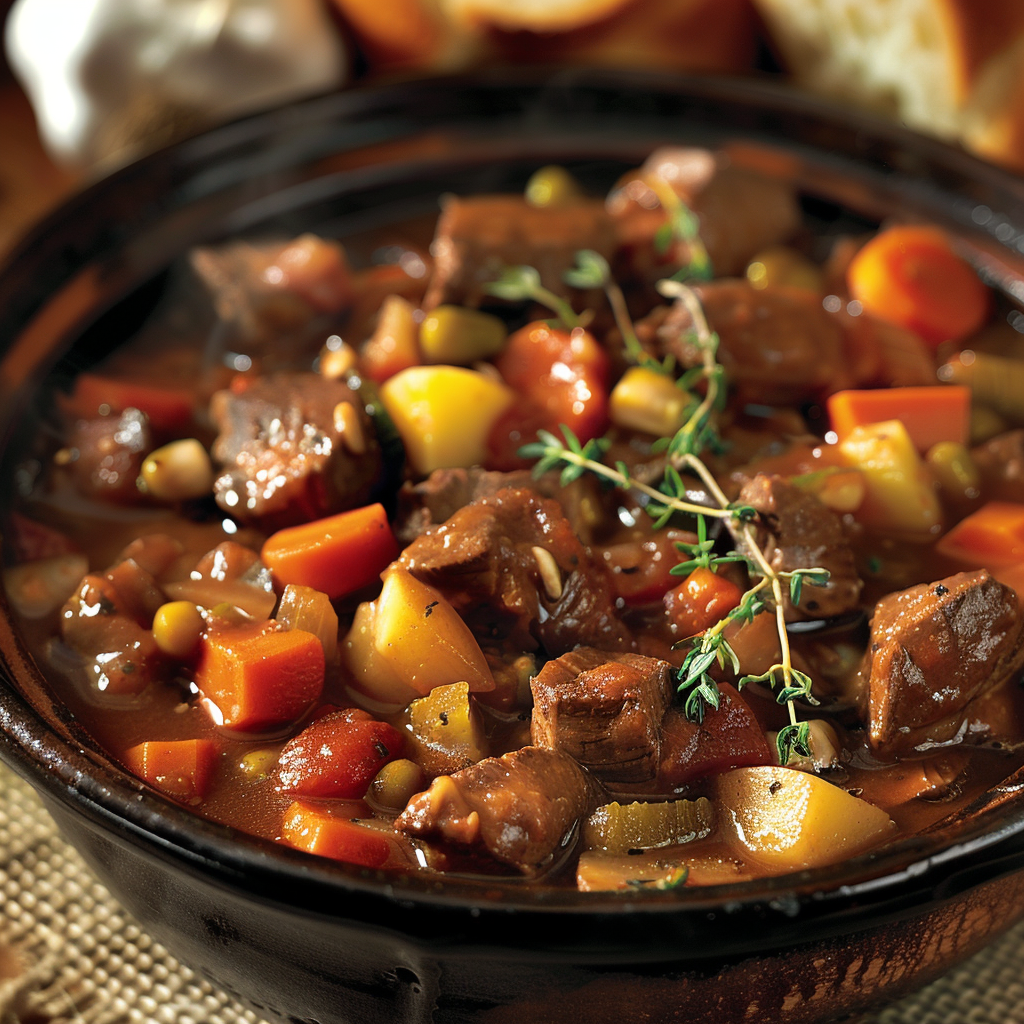Mulligan Stew is a hearty and flavorful dish that has been enjoyed by many for generations. This classic Irish dish is made with a variety of ingredients, including beef, vegetables, and beans, and is typically slow-cooked to perfection. The origins of Mulligan Stew can be traced back to the early 1900s, when it was said to have been prepared by American hobos in camps.
Over the years, Mulligan Stew has become a staple in many households and is often served at community events and gatherings. The dish has also evolved to include a variety of different ingredients and variations, depending on the region and personal preferences. Despite its humble beginnings, Mulligan Stew has become a beloved dish that is enjoyed by many around the world.
Key Takeaways
- Mulligan Stew is a classic Irish dish made with beef, vegetables, and beans that has been enjoyed for generations.
- The dish originated in the early 1900s and was said to have been prepared by American hobos in camps.
- Mulligan Stew has become a staple in many households and has evolved to include a variety of different ingredients and variations.
Historical Origins
Etymology
The origins of the term “Mulligan Stew” are somewhat uncertain. Some sources claim that the word “Mulligan” is a corruption of the Irish Gaelic word “meallagan,” which means a dish made from odds and ends. Others suggest that the word comes from the name of a Canadian chef named Mulligan, who was famous for making stews from whatever ingredients he had on hand.
Regardless of its etymology, Mulligan Stew has a long history in North America. It was a popular dish among hobos and other itinerant workers during the early 20th century, who would often make the stew from whatever ingredients they could scavenge. The dish was also a staple of the logging camps and mining towns of the American West, where it was often made in large cauldrons over open fires.
Early Recipes
The earliest recipes for Mulligan Stew were very simple, consisting of little more than meat, potatoes, and onions. Over time, however, the dish evolved to include a wider variety of ingredients, including vegetables, beans, and grains. Some recipes even called for the addition of beer or wine to give the stew a richer flavor.
One of the earliest published recipes for Mulligan Stew appeared in the 1910 edition of “The Settlement Cook Book,” a popular cookbook aimed at immigrant women. The recipe called for beef, potatoes, onions, and carrots, cooked together in a large pot with water and seasonings. Another early recipe, published in a 1927 issue of “Good Housekeeping” magazine, called for the addition of canned tomatoes, rice, and green peppers.
Despite its humble origins, Mulligan Stew has remained a popular dish in North America to this day. It is often served at community events and potlucks, where it is still made from whatever ingredients are on hand.

Cultural Significance
Mulligan Stew has a cultural significance that goes beyond its humble ingredients. The dish is said to have originated from the early 1900s, where it was prepared by American hobos in camps. Mulligan Stew was a communal dish made by combining whatever food the hobos had or could collect 1.
In Literature
Mulligan Stew has been mentioned in various literary works.For instance, in John Steinbeck’s novel “The Grapes of Wrath,” the character Tom Joad enjoys a pot of Mulligan Stew with his fellow travelers. Similarly, in Jack Kerouac’s “On the Road,” protagonist Sal Paradise savors a bowl of Mulligan Stew in a hobo jungle. 3.
In Media
Mulligan Stew has been featured in various films and TV shows. For instance, in the movie “Sullivan’s Travels,” the main character John Sullivan disguises himself as a hobo and eats Mulligan Stew with his fellow vagabonds 4. In the TV show “Downton Abbey,” the character Daisy prepares a pot of Mulligan Stew for the servants’ dinner 5.
Mulligan Stew’s cultural significance lies in its association with the working-class and the downtrodden. The dish symbolizes resilience, unity, and shared humanity that was born out of challenging times 6. Today, Mulligan Stew has evolved from its “anything goes” origin and is enjoyed by people from all walks of life.
Ingredients and Variations
Traditional Ingredients
Mulligan Stew is a hearty and filling dish that typically includes beef, potatoes, onions, and carrots. Other common ingredients include garlic, celery, and various herbs and spices such as bay leaves, oregano, and basil. The stew is typically thickened with flour or cornstarch and often includes canned or frozen vegetables such as peas, corn, and green beans.
Regional Variations
While the traditional ingredients of Mulligan Stew remain fairly consistent, there are many regional variations of the dish. In some areas, the stew may include additional vegetables such as turnips, parsnips, or rutabagas. Some recipes call for the addition of beer or red wine to enhance the flavor of the stew.
In the southern United States, Mulligan Stew is often referred to as “Hobo Stew” and may include ingredients such as lima beans, cabbage, and okra. Some versions of the stew may also include spicy ingredients such as jalapenos or chili powder.
In Ireland, Mulligan Stew is often made with lamb instead of beef and may include ingredients such as barley, leeks, and thyme. The stew is often served with Irish soda bread.
Overall, Mulligan Stew is a versatile dish that can be adapted to suit a variety of tastes and preferences. Whether you prefer a traditional version of the stew or a regional variation, Mulligan Stew is sure to satisfy your appetite and warm you up on a chilly evening.
Preparation Techniques
Cooking Methods
Mulligan stew can be cooked in a variety of ways, including on the stovetop, in a slow cooker, or in the oven. Regardless of the cooking method, it is important to brown the beef before adding it to the stew. This not only adds flavor but also helps to seal in the juices.
For stovetop cooking, the beef is browned in a skillet before being added to the stew pot. The onions and garlic are also cooked in the skillet before being added to the pot. The stew is then cooked on low heat for several hours until the meat is tender.
For slow cooker cooking, the beef is also browned in a skillet before being added to the slow cooker. The onions and garlic are cooked in the skillet before being added to the slow cooker. The stew is then cooked on low heat for several hours until the meat is tender.
For oven cooking, the beef is browned in a Dutch oven before being added to the pot with the other ingredients. The stew is then cooked in the oven for several hours until the meat is tender.
Serving Suggestions
Mulligan stew is a hearty and satisfying dish that can be served on its own or with a variety of sides. Some popular serving suggestions include crusty bread, mashed potatoes, or rice. The stew can also be garnished with fresh herbs or a dollop of sour cream.
To make the dish more flavorful, some cooks like to add additional seasonings such as bay leaves, thyme, or Worcestershire sauce. Others like to add vegetables such as carrots, potatoes, or peas to make the dish more nutritious.
Regardless of how it is served, Mulligan stew is a classic dish that is sure to please.
Nutritional Information
Caloric Content
Mulligan Stew is a hearty and filling dish that is perfect for cold winter nights. It is made with a variety of ingredients, including beef, potatoes, carrots, and other vegetables. The caloric content of Mulligan Stew can vary depending on the recipe and the serving size.
According to Taste of Home, a serving of Mulligan Stew that is 1-1/3 cups contains approximately 300 calories. This serving size also contains 24 grams of protein, 10 grams of fat, and 29 grams of carbohydrates. However, it is important to note that the caloric content can vary depending on the specific recipe and the ingredients used.
Dietary Considerations
Mulligan Stew can be a nutritious and healthy meal option, but it is important to consider certain dietary restrictions and considerations. For example, individuals who are watching their sodium intake should be careful when consuming Mulligan Stew, as it can be high in sodium.
However, there are ways to make Mulligan Stew healthier and more nutritious. For example, using lean cuts of beef and adding more vegetables can increase the nutritional value of the dish. Additionally, using low-sodium beef broth or homemade broth can reduce the overall sodium content of the stew.
Overall, Mulligan Stew can be a delicious and satisfying meal option, but it is important to consider the caloric content and dietary restrictions when consuming this dish. By making small adjustments and using healthy ingredients, individuals can enjoy this classic stew while still maintaining a healthy and balanced diet.
Pairing and Cuisine
Wine and Beverage Pairings
Mulligan Stew is a hearty and savory dish that pairs well with a variety of beverages. Red wine is a classic pairing for beef-based stews, and Mulligan Stew is no exception. A full-bodied red wine such as Cabernet Sauvignon or Merlot can complement the rich flavors of the stew. For those who prefer white wine, a Chardonnay or Sauvignon Blanc can also work well.
For non-alcoholic options, a glass of cold beer or a mug of hot apple cider can be a great accompaniment to the stew. The carbonation of beer can help cut through the richness of the stew, while the sweetness of apple cider can complement the savory flavors.
Complementary Dishes
Mulligan Stew, a satisfying meal on its own, pairs well with complementary dishes to enhance variety and balance. A crisp green salad dressed with vinaigrette offers a refreshing contrast to the hearty stew. Enjoy warm slices of crusty bread or dinner rolls to soak up the savory broth, adding an extra layer of comfort.
For vegetable enthusiasts, roasted or steamed root vegetables like carrots, parsnips, and turnips can elevate the meal with their sweet and earthy flavors, complementing the savory stew.
In conclusion, Mulligan Stew’s versatility shines as it harmonizes with various beverages and side dishes. Whether you prefer a glass of red wine or a mug of hot cider, Mulligan Stew promises to delight your palate and warm your spirit.
Home Cooking Tips
Ingredient Substitutions
Mulligan Stew is a flexible recipe that can be adjusted to suit your preferences or the ingredients you have on hand. If you don’t have beef, you can substitute it with chicken, pork, or lamb. You can also use a combination of meats. For a vegetarian version, you can use mushrooms, tofu, or tempeh instead of meat.
If you don’t have some of the vegetables called for in the recipe, you can substitute them with other vegetables that you like or that are in season. For example, you can use sweet potatoes instead of regular potatoes, or green beans instead of peas. You can also add other vegetables to the stew, such as bell peppers, zucchini, or corn.
Cookware Recommendations
Mulligan Stew can be cooked in various pots, depending on your preference and quantity. A Dutch oven is popular for its versatility on stovetops or in ovens, and its ample capacity. Alternatively, a slow cooker offers convenience if you prefer a “set it and forget it” approach.
If you lack a Dutch oven or slow cooker, opt for a large oven-safe pot or casserole dish with a lid. Ensure it’s spacious enough to comfortably accommodate all ingredients, avoiding overcrowding.
By following these ingredient substitutions and cookware recommendations, you can create a delicious and unique Mulligan Stew that suits your taste and cooking style.

